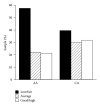Obesity and african americans: physiologic and behavioral pathways
- PMID: 24533220
- PMCID: PMC3901988
- DOI: 10.1155/2013/314295
Obesity and african americans: physiologic and behavioral pathways
Abstract
Although progress has been made to understand the association between physiological and lifestyle behaviors with regard to obesity, ethnic differences in markers of obesity and pathways towards obesity remain somewhat unexplained. However, obesity remains a serious growing concern. This paper highlights ethnic differences in African Americans and Caucasians that may contribute to the higher prevalence of obesity among African Americans. Understanding ethnic differences in metabolic syndrome criteria, functioning of the hypothalamic pituitary adrenal axis, variations in glucocorticoid sensitivity and insulin resistance, and physical activity and cardiovascular fitness levels may help to inform practical clinical and public health interventions and reduce obesity disparities.
Figures

References
-
- Flegal KM, Carroll MD, Ogden CL, Curtin LR. Prevalence and trends in obesity among US adults, 1999–2008. Journal of the American Medical Association. 2010;303(3):235–241. - PubMed
-
- Wadden TA, Brownell KD, Foster GD. Obesity: responding to the global epidemic. Journal of Consulting and Clinical Psychology. 2002;70(3):510–525. - PubMed
-
- Duncan GE, Anton SD, Newton RL, Jr., Perri MG. Comparison of perceived health to physiological measures of health in black and white women. Preventive Medicine. 2003;36(5):624–628. - PubMed
-
- Weinsier RL, Hunter GR, Zuckerman PA, et al. Energy expenditure and free-living physical activity in black and white women: comparison before and after weight loss. The American Journal of Clinical Nutrition. 2000;71(5):1138–1146. - PubMed
Publication types
LinkOut - more resources
Full Text Sources
Other Literature Sources
